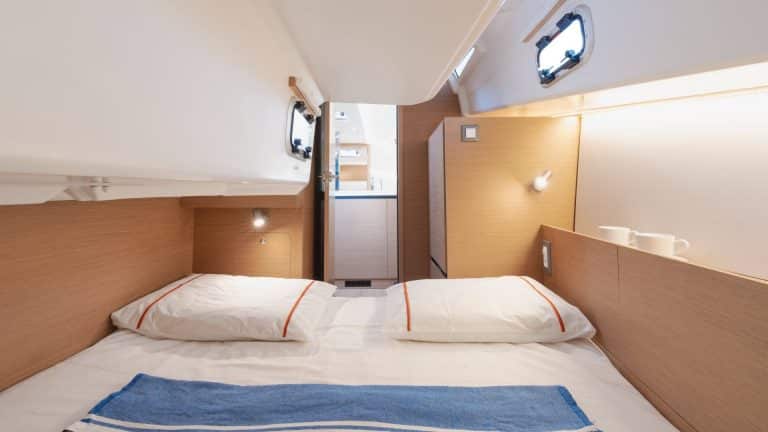The Mediterranean Sea is undoubtedly one of Europe’s finest sailing destinations. With more than 20 countries sharing a coastline with the Mediterranean, the area is full of islands and breathtaking scenery to appreciate. However, most sailors and tourists visit during the summer, and only experience a fraction of what the region has to offer. For this reason, today we tell you what is the best time to sail in the Mediterranean Sea.
The Mediterranean has a lot to offer sailors and allows sailing practically all year round. Even so, it will always depend on the weather and sea conditions. In the Mediterranean, we can find 9 types of winds, which are named with their own name and change depending on the time of the year. It is essential to have a basic knowledge of the seasonal winds to plan your route, so we recommend consulting meteorology apps, as well as isobaric charts, which will help you to draw conclusions for a first step in meteorological routing.
A practical way to recognise the direction of the winds is through the compass rose or compass rose because, unlike the compass, the cardinal points on the compass rose represent the geographic point, not the magnetic point.

The winds of the Mediterranean Sea
One of the most important factors in determining the best weather for sailing in the Mediterranean Sea is to take into account the prevailing winds. Here is a brief explanation of where they come from and their conditions.
The Tramontana
This is a cold and turbulent wind from the NE or N, which in Spain blows mainly over the Balearic Islands archipelago and the northeast of Catalonia. This wind accelerates as it passes between the northern Pyrenees and the southwest of the Massif Central (France), reaching the Mediterranean.
The Levante Wind
It originates in the central Mediterranean and in the vicinity of the Balearic Islands. When blowing moderately or strongly, the Levante causes strong swells in the Mediterranean. It is generally mild and humid, often bringing clouds and rain. However, the wind reaches its highest speed when it crosses the Strait of Gibraltar.
The Garbí

It is a southwesterly wind and is caused by the movement of storms in the southern Mediterranean from west to east. This movement causes the displacement of hot, dry air masses from the desert towards the southeast of Spain. Due to its origin it is usually accompanied by sand and dust in the air because it comes from the Sahara desert.
The Mistral
It is a NW wind (sometimes from the north) that blows from the Mediterranean coasts towards the sea, between the mouth of the Ebro and Genoa. It is a cold, dry and violent wind, usually reaching 100 km/h and sometimes exceeding 140 km/h (75 knots). It can be caused by night-time cooling of the ground in coastal regions, or a rise in atmospheric pressure in north-western Europe when it blows very strongly.
The westerly wind
It is a wind from the W, it is warm and humid, and it receives its name because it blows from the direction in which the sun sets. This wind, in the Spanish Mediterranean, increases its temperature and dries out as it descends the Meseta and reaches the Spanish Levante, due to the Foehn effect. This provides pleasant temperatures during the winter in the Valencian Community and the Region of Murcia, but in summer it is an extraordinarily hot, dry and sustained wind.
The Gregal
It is a NE wind that is produced when the low pressure (squall) moves towards the south of Malta. It is present in the central Mediterranean off the coasts of Sicily, Malta and the Ionian Sea. In Spain, it is a characteristic wind of the Balearic Islands, which blows especially during the month of February. The Gregal is a cold and dry wind that often has the force of a storm, producing strong swells and swell.
The Sirocco
This is a SE wind typical of the Mediterranean. It comes from the Sahara and reaches hurricane speeds in North Africa and southern Europe. It usually brings a reddish dust from the Sahara sand creating low visibility on the coasts. The sirocco is formed by depressions formed under the Mediterranean that move northeastward across the Sahara desert. Upon reaching the sea and encountering cooler, more humid air, they cause heavy rain and storms capable of reaching winds of up to 40-50 knots.

The Bora wind
It is a katabatic wind blowing from the N-NE in the Adriatic Sea, Croatia, Italy, Greece, Slovenia and Turkey. It is cold and dry due to the formation of a seasonal cyclone in the Mediterranean Sea. It usually blows in gusts and is a frequent wind mainly in winter.
The Meltemi
This is a strong, dry northerly wind, which affects the Aegean coasts (Greece) and blows from mid-May to mid-September. During the long summer days, it is the most common wind, but be aware that this wind is dangerous for sailors because it comes in clear weather, without warning, and can reach 7-8 on the Beaufort scale!
So what is the best weather for sailing in the Mediterranean?
In general, the best weather for sailing in the Mediterranean Sea starts in early April until late September or October, as these tend to be the warmest months with the least rainfall. However, it is possible to sail in different areas of the Mediterranean all year round. You will have to take into account the sea conditions and factors such as the weather and wind in each place you want to sail.






